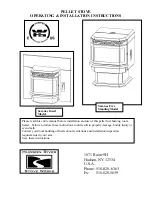
15
INSTALLING YOUR ROOM HEATER
HORIZONTAL EXHAUST VENT INSTALLATION
1.
Locate your appliance in a location which meets the requirements of this manual
and where it does not interfere with the house framing, wiring, etc..
2.
Install a non-combustible hearth pad underneath the unit. This pad should extend
at least 6” (152 mm) in front of the unit.
3.
Place the stove approximately 15” (381 mm) away from the interior wall.
4.
Locate the center of the exhaust pipe of your unit. This point should then be
extended to the interior wall of your house. Once you have located the center
point, on the interior wall, cut a 7” (175 mm) diameter hole through the wall.
5.
The next step is to install the wall thimble, refer to the instructions which come
with the wall thimble for this step.
6.
Install the appropriate length of exhaust vent pipe into the wall thimble. See step
11 when determining the correct length of exhaust vent to use.
7.
Install the optional combustion air intake pipe. The unit has an option to utilize
outside air for combustion. Be sure that the outside air vent has a proper cap on it
to prevent rodents from entering and also is installed where it won’t become
blocked with snow, etc..
8.
Connect the exhaust vent pipe to the exhaust outlet of your appliance.
9.
Secure all vent joint connections with 3 screws. Seal the exhaust vent joint
connections with high temperature silicone sealant.
10.
Push the unit straight back to the interior wall but be sure to maintain the
minimum clearances to combustibles 6” (152 mm) to the back of the unit. Seal
the annular space, of the wall thimble, around the vent pipe with high temperature
silicone sealant.
11.
The exhaust vent pipe must extend at least 12” (300 mm) out past the exterior
wall. Seal the annular space, of the wall thimble, around the vent pipe with high
temperature silicone sealant.
12.
Install a listed horizontal termination cap or if necessary install a 90
°
elbow and
appropriate length of vertical venting. A listed vertical vent cap is recommended
however (if local codes allow) when the vent terminates several feet above ground
level and there are no trees, plants, etc. within several feet a 45
°
elbow can be
used as a termination. The elbow must be turned down to prevent rain from
entering.






























